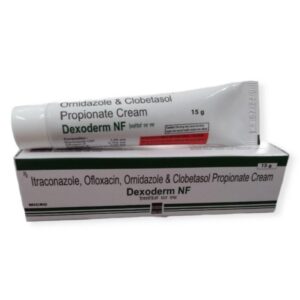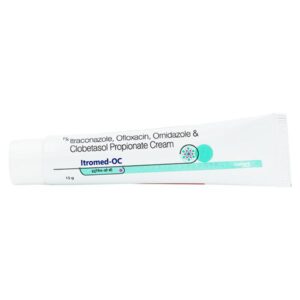ORNIDAZOLE + OFLOXACIN + CLOBETASOL + ITRACONAZOLE
Ornidazole: Ornidazole is an antimicrobial and antiprotozoal drug used to treat certain infections caused by bacteria and protozoa. It is primarily prescribed for the treatment of amoebiasis, trichomoniasis (a sexually transmitted infection caused by a protozoan parasite), giardiasis (a parasitic infection of the small intestine), and various other types of infections.
The mechanism of action of Ornidazole involves damaging the DNA of the microorganisms, leading to their death. It acts by forming free radicals which cause DNA breakage and inhibiting the synthesis of DNA and RNA. This action helps in eradicating the pathogenic microorganisms responsible for the infections.
The dosage of Ornidazole can vary depending on the type and severity of the infection, as well as the individual’s age and other medical conditions. Generally, the recommended oral dosage for adults is 500 mg to be taken once or twice a day. It is usually taken after meals to minimize stomach upset.
As with any medication, Ornidazole has potential side effects. Common side effects include nausea, vomiting, dizziness, headache, dry mouth, metallic taste in the mouth, and gastrointestinal disturbances such as diarrhea or abdominal pain. These side effects are usually mild and resolve on their own.
Rare but serious side effects may occur, such as allergic reactions (rash, itching, swelling), neurological effects (such as numbness, tingling, or weakness in the limbs), or changes in vision. If any severe or persistent side effects are experienced, it is important to seek medical attention promptly.
Ornidazole should not be used during pregnancy, as it can harm the fetus. It should also be used with caution in individuals with liver impairment, as the drug is metabolized by the liver.
It is crucial to complete the full course of Ornidazole treatment as prescribed by the healthcare provider, even if symptoms improve before completion. Skipping doses or stopping treatment prematurely may result in the infection not being fully eradicated.
As with any medication, it is important to consult a healthcare professional for appropriate diagnosis, dosage, and guidance on any potential drug interactions or precautions before starting Ornidazole.
Ofloxacin: Ofloxacin is an antibiotic medication belonging to the class of drugs called fluoroquinolones. It is commonly used to treat various bacterial infections, including urinary tract infections, respiratory tract infections, skin and soft tissue infections, as well as sexually transmitted infections like gonorrhea. This drug works by inhibiting the activity of enzymes called DNA gyrase and topoisomerase IV, which are essential for the replication and repair of bacterial DNA.
The dosage of Ofloxacin can vary depending on the condition being treated and the severity of the infection. It is typically taken orally, with or without food. The usual adult dose for most infections is around 200-400 mg taken twice daily. However, the specific dosing instructions should be determined by a healthcare professional.
As with any medication, Ofloxacin may cause certain side effects. Common side effects may include nausea, headache, dizziness, diarrhea, and changes in taste sensation. These side effects are generally mild and go away on their own. However, if they persist or worsen, it is advisable to consult a healthcare provider. Ofloxacin may also cause rare but serious side effects such as tendonitis or tendon rupture, allergic reactions, and central nervous system effects like seizures or hallucinations. It is important to seek medical attention immediately if any severe or unusual side effects occur.
Ofloxacin should be used with caution in individuals with a history of tendon disorders, as it may increase the risk of tendonitis or tendon rupture. It is not recommended for use during pregnancy, as it may harm the developing fetus. Breastfeeding women should also avoid using Ofloxacin, as it can be excreted in breast milk.
In conclusion, Ofloxacin is a fluoroquinolone antibiotic used to treat a variety of bacterial infections. It works by interfering with bacterial DNA replication. While generally effective, it may cause side effects, including nausea, headache, and diarrhea. It is important to follow the prescribed dosage and consult a healthcare professional if any severe side effects occur.
Clobetasol: Clobetasol is a potent corticosteroid medication used to treat various skin conditions such as eczema, psoriasis, dermatitis, and other inflammatory skin disorders. It belongs to the class of drugs called topical corticosteroids.
The mechanism of action of clobetasol involves reducing inflammation, itching, and redness by suppressing the immune response in the affected area. It works by inhibiting the production of inflammatory mediators and enzymes, as well as reducing the activity of immune cells in the skin.
Clobetasol is available as a cream, ointment, lotion, or foam, and the dosage and duration of use depend on the specific skin condition being treated. It is generally meant for short-term use and should not be used on large areas of the body or for an extended period without proper medical supervision.
Common side effects of clobetasol include skin irritation, burning or stinging sensation, dryness, redness, or itching at the application site. Long-term use of this medication or excessive application can lead to more serious side effects such as skin thinning, discoloration, stretch marks, or the development of skin infections.
It is essential to follow the prescribed dosage and not exceed it. Avoid applying this medication to the face, groin, or underarms unless explicitly directed by a healthcare professional. Additionally, individuals with known allergies to clobetasol or other corticosteroids should avoid using this medication. It is always advisable to consult a healthcare provider before using any medication to ensure it is appropriate for your condition.
Itraconazole: Itraconazole is an antifungal medication that is used to treat various fungal infections. It is commonly prescribed for infections caused by fungi that affect the skin, nails, or respiratory system.
The mechanism of action of itraconazole involves inhibiting the synthesis of ergosterol, which is a key component of fungal cell membranes. By interfering with the synthesis of ergosterol, itraconazole disrupts the structure and function of the fungal cell, ultimately leading to its death.
The dosage of itraconazole can vary depending on the type and severity of the infection being treated. It is available in various forms, including tablets, capsules, and oral solution. The prescribed dose may range from 100 to 400 mg per day, and the duration of treatment can vary from a few weeks to several months.
As with any medication, itraconazole has a range of potential side effects. Common side effects may include nausea, diarrhea, stomach pain, headache, and skin rash. Other possible side effects include liver problems, heart problems such as irregular heart rhythm, dizziness, and allergic reactions. It is important to notify a healthcare provider if any severe or persistent side effects occur.
It is worth noting that itraconazole can interact with certain medications, so it is important to inform your healthcare provider about any other medications you are taking to avoid potential drug interactions.
Overall, itraconazole is a widely used antifungal medication that effectively treats fungal infections. However, it is essential to follow the prescribed dosage and consult a healthcare provider for proper monitoring and to minimize the risk of side effects.



